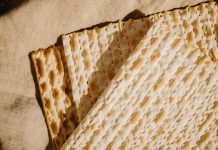Greetings InCultureParent readers. My name is Josh Ratner, and I will be taking a monthly stab at describing what it is like to raise my three, beautiful children, Dimitri (age 7), Eli (age 4), and Gabriella (age 9 months), along with my wife Elena (who is a physician), as Jews. I hope I will be able to offer some interesting insights. I come at this topic both as a current rabbinical student and as someone living in suburbia with all the secular challenges and enticements that entails. I am originally from San Diego, CA but have been living on the East Coast for about 15 years. Our family presently lives in Connecticut, about an hour outside of New York City.
For my first post, I would like to share some recent thoughts I had about how to transmit the meaning of the holidays to my children. Fortunately, many Jewish festivals come complete with their own special foods or other customs, whether it is dipping apples in honey on Rosh Hashanah or lighting candles, playing dreidel, and opening presents on Chanukah. These help when giving a superficial explanation to my younger kids (such as apples and honey for a sweet New Year). But is this all there is? And will it be sufficient to keep their interest as they get older?
Last month, during Passover, I was once again reminded of how brilliant our religious traditions sometimes can be. The Passover Seder has little Biblical basis. Instead, it was created by rabbis roughly 2000 years ago to evoke a sense of freedom and comfort, consistent with the biblical story of the Israelites’ deliverance from slavery in Egypt to freedom. The rabbis sought to achieve this by ritualizing some of the most prominent features of the Roman symposium, which served them as a model for freedom and success (for those who don’t recall their Plato, the symposium was a festive meal where the elites would recline, enjoy leisurely dining, and tell each other educational stories). But the early rabbis did not stop there. Instead, they designed the Seder pedagogically. In a manner that would make John Dewey proud, the rabbis instituted a variety of odd customs (washing hands twice, dipping a variety of vegetables, reclining while eating, etc.) whose entire purpose was to get children to ask, “Why is this night different from all other nights?” Once kids ask this magic question, the rest of the evening is supposed to be dedicated to teaching them about the exodus from Egypt and what it means to be free.
I’ll admit, though, it isn’t easy, even with the whole Seder laid out in advance in a book called the Haggadah, to make it work right. I was brought up with Passover Seders that were anything but didactic. Instead, they usually involved adults reading every English word in the Haggadah, cover to cover, and calling on the kids whenever a musical interlude was needed. Once we learned enough of the songs, it became fun to be able to participate but I didn’t really learn the meaning of Passover. Now that I am planning and running my own Seders, the onus is on me to figure out how to make the Seder fun and engaging. Frankly, making religion creative isn’t one of my strong points.
What I learned this year is that being creative means I have to experiment, even if some of these experiments fail. In most normal contexts, failure is scary, but in a religious context, it can seem downright terrifying. After all, if we are supposed to be honoring God and doing something sacred, isn’t failure really serious? In the Bible, people are killed for screwing up their religious duties (Aaron’s sons, Nadav and Avihu, as but two examples, are instantly killed by God for offering sacrifices in an improper manner). Yet experiential learning requires us to try out different approaches, even though we know that some might not pan out as we planned.
This year, I used a Haggadah that had some built-in, kid-friendly ideas. I decided to try out three of its suggestions. First, for the part of the service where people are supposed to wash their hands, I had my two boys carry around the water pitcher, along with a basin, and wash everyone’s hands. Second, in order to help the kids feel like they, too, were reclining and eating in luxury, I spread out a blanket on the floor next to the dining room so they could eat and not feel confined to a table for what is a lengthy dinner/service. Third, I told the children to enact a skit about the Israelites’ transition from slavery to freedom.
Two out of the three worked well. The kids liked washing everyone’s hands and felt included in a part of the service where they usually would tune out. The blanket, while initially popular with the children, turned out to be a bad idea because they spilled grape juice all over the place and kept wandering off since there were no tables or chairs to confine them. Finally, the skit was probably the highlight of the Seder. The kids practiced it while we ate and then performed it with delight when it was time to finish dinner. Instead of the adults relaying in words what the exodus was like, they got to tell us, through their words and actions, what the exodus meant. I guess we all had something to learn this Passover.


































